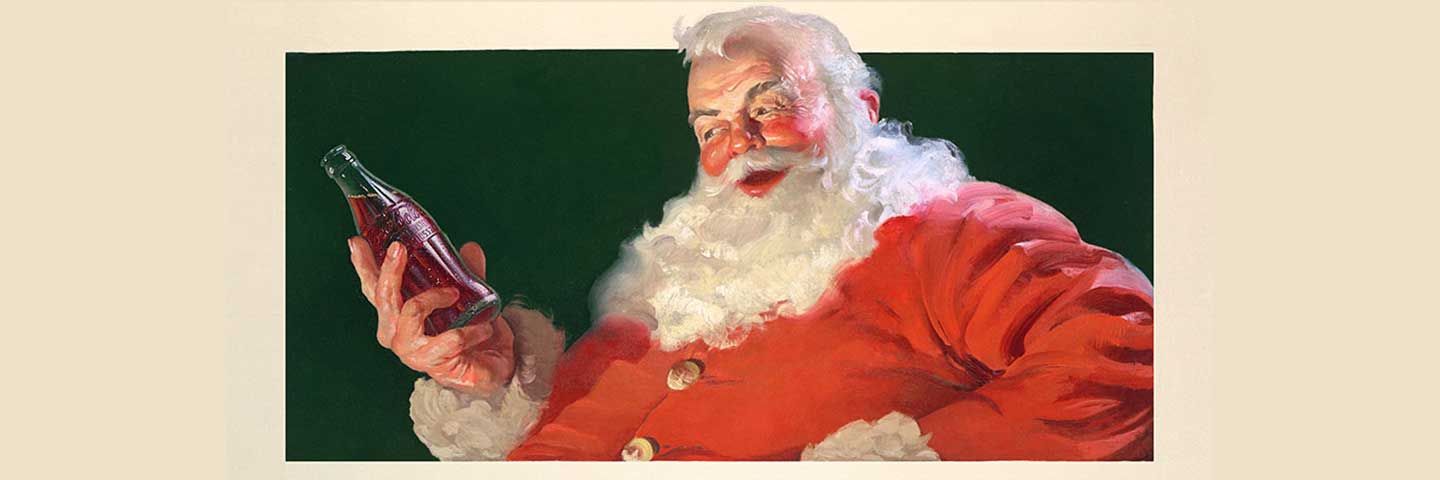Haddon Sundblom and the Coca-Cola Santas
Five things you never knew about Santa Claus and Coca-Cola
The Santa Claus we all know and love, the big, jolly man with a red suit and white beard, hasn't always pulled it off. In fact, many are surprised to learn that before 1931, Santa Claus was depicted as anything from a tall man to a scary-looking elf. He wears a bishop's robe and the animal skins of a Norse hunter. In fact, when Civil War cartoonist Thomas Nast drew Santa Claus for Harper's Weekly in 1862, Santa Claus was a small elf-like figure who supported the Union. Nast dressed as Santa Claus for 30 years, changing his fur color from brown to red.
Here are some more facts you may not know about the happy man in red.
1. Santa Claus has appeared in Coca-Cola advertisements since the 1920s.
The Coca-Cola Company began its Christmas advertising in the 1920s with shopping-related ads in magazines such as the Saturday Evening Post. Early Santa Claus advertisements used a stern-looking Claus in the vein of Thomas Nast.
In 1930, artist Fred Maison painted a department store Santa Claus in a crowd, drinking from a Coca-Cola bottle. The ad shows the world's largest soda fountain located in the famous Bar Company department store in St. Louis. Mizen's painting was used in Christmas print advertisements in The Saturday Evening Post in December 1930.
2. Coca-Cola helped shape the image of Santa Claus
In 1931, the company began placing Coca-Cola advertisements in popular magazines. Archie Lee, an executive at the D'Arcy advertising agency working with the Coca-Cola Company, wanted the campaign to show a healthy, realistic and symbolic Santa Claus. So Coca-Cola commissioned Michigan-born artist Haddon Sundblom to create advertising images using Santa Claus—not a man dressed as Santa Claus, but Santa Claus himself.
For inspiration, Sundblom turned to Clement Clark Moore's 1822 poem "A Visit from Saint Nicholas" (commonly known as "Twas the Night Before Christ"). Moore's description of Saint Nicholas led to the image of a warm, friendly, pleasantly plump and humane Santa Claus. (Although Santa Claus is often said to wear a red coat because of the color of Coca-Cola, Santa Claus appeared in a red coat before Sundblom painted him.)
Sundblom's Santa Claus began appearing in Coca-Cola advertisements in The Saturday Evening Post in 1931 and appeared regularly in that magazine, as well as in Ladies Home Journal, National Geographic, The New Yorker and others.
From 1931 to 1964, Coca-Cola advertising showed Santa Claus delivering toys (and playing with them), stopping to enjoy a Coca-Cola after reading a letter, stopping with children to greet them, and raiding refrigerators in many locations. . Homemade. The original oil paintings created by Sundblom were adapted for Coca-Cola advertisements in magazines and store windows, billboards, posters, calendars and stuffed animals. Today, many of those items are popular collectibles.
Sundblom created the final version of Santa in 1964, but for several decades afterward, Coca-Cola advertising featured images of Santa based on Sundblom's original works. These paintings are among the most valuable pieces in the art collection of the company's archives department and are displayed in prominent venues such as the Louvre in Paris, the Royal Ontario Museum in Toronto, and the Museum of Science and Industry. Iseton department store in Chicago, Tokyo and NK department store in Stockholm. Many of the original paintings are displayed at the World of Coca-Cola in Atlanta, Georgia.
Santa Claus Magazine Ad I take my hat off
3. "The New Santa" was based on a salesman
At first, Sundblom painted the image of Santa Claus using a live model: his friend, retired salesman Lou Prentice. When Prentice died, Sundblom painted himself on a mirror, using himself as a model. Eventually, he began to rely on photographs to create the image of Saint Nicholas.
People loved the Coca-Cola Santa figures and paid so much attention to them that when something changed, they sent letters to the Coca-Cola Company. One year, Santa's big belt was upside down (maybe Sundblom painted a mirror). Another year, Santa showed up without a wedding ring, leading fans to wonder what happened to Mrs. Claus.
The children who appear with Santa Claus in Sundblom's paintings were inspired by Sundblom's neighbors: two little girls. He then changed a child into the paintings of him.
The dog in Sundblom's 1964 painting of Santa Claus is actually a gray poodle owned by the owner of a neighboring flower shop. But Sundblom wanted
4. Santa Claus got a new friend in 1942
In 1942, Coca-Cola introduced "Sprite Boy", a character who appeared with Santa Claus in Coca-Cola advertising during the 1940s and 1950s. Sprite Boy, who was also created by Sundblom, was named after the fact that he was an elf or elf. (It wasn't until the 1960s that Coca-Cola introduced the popular Sprite drink.)



Comments
Post a Comment